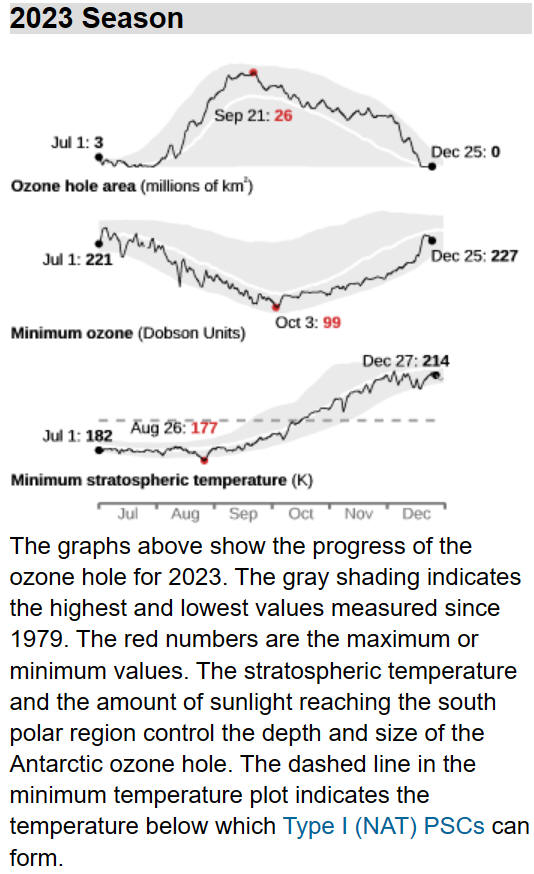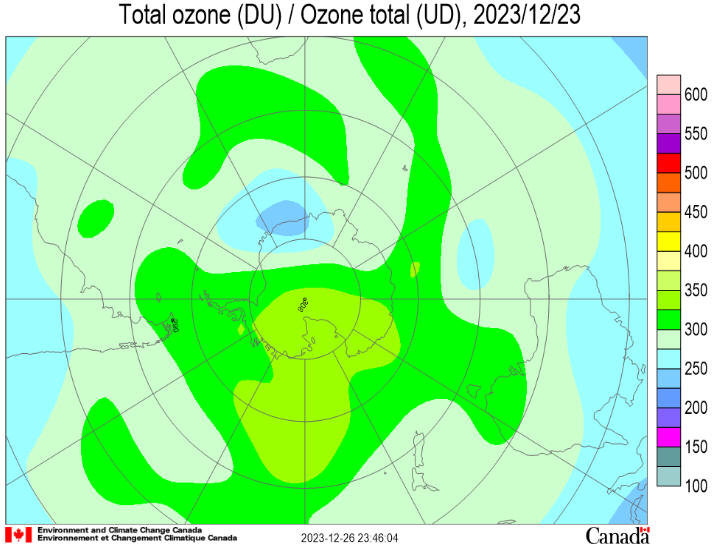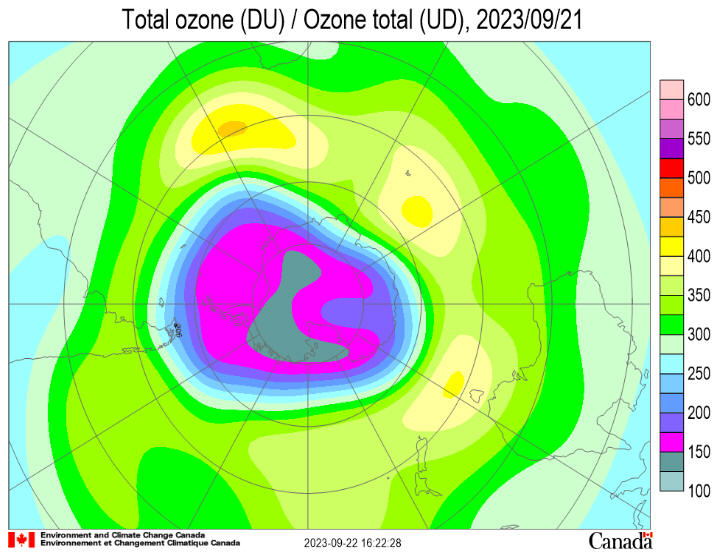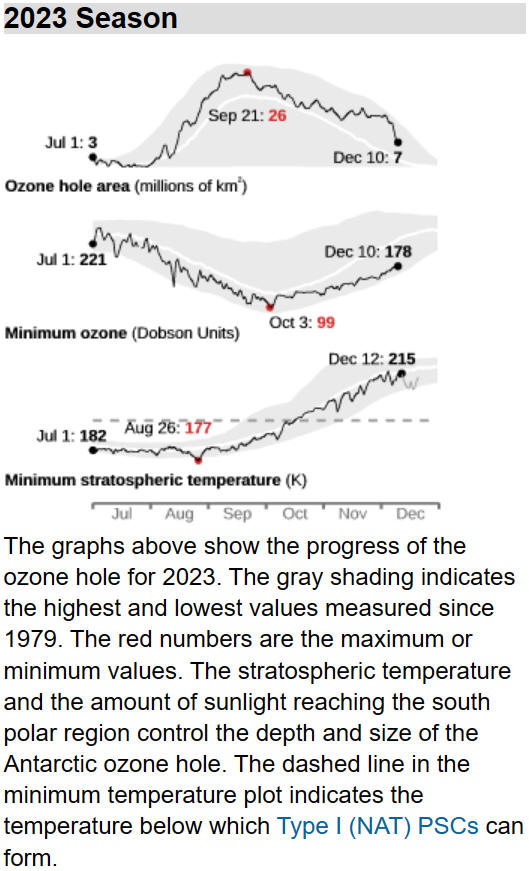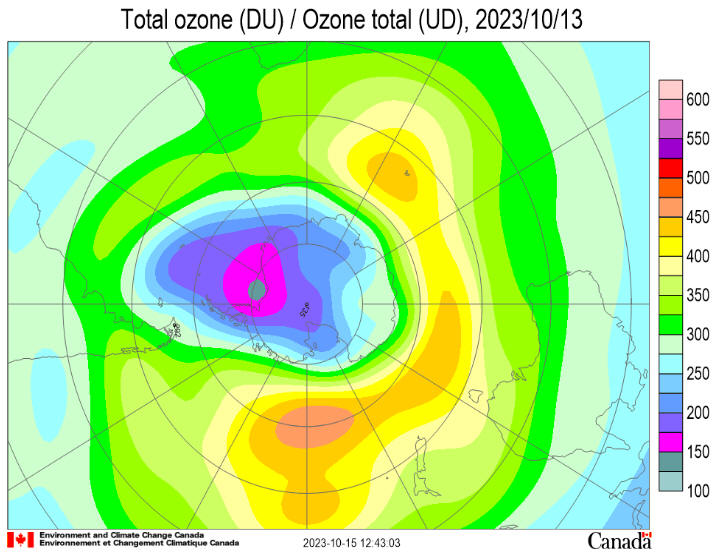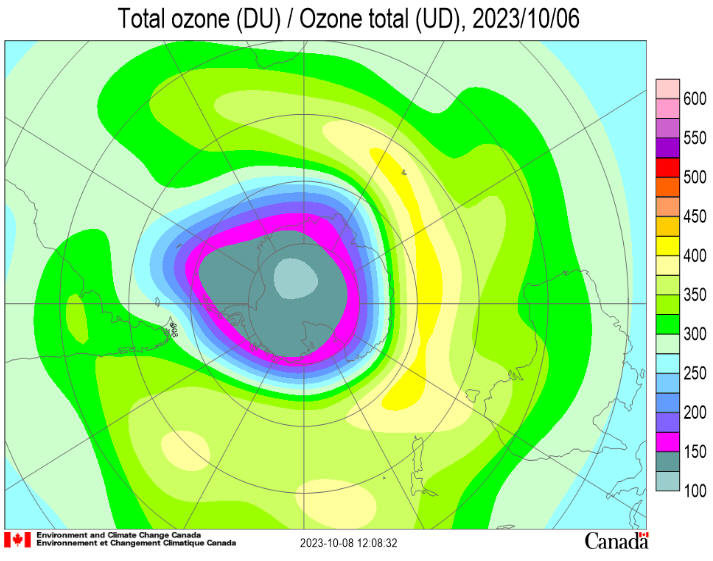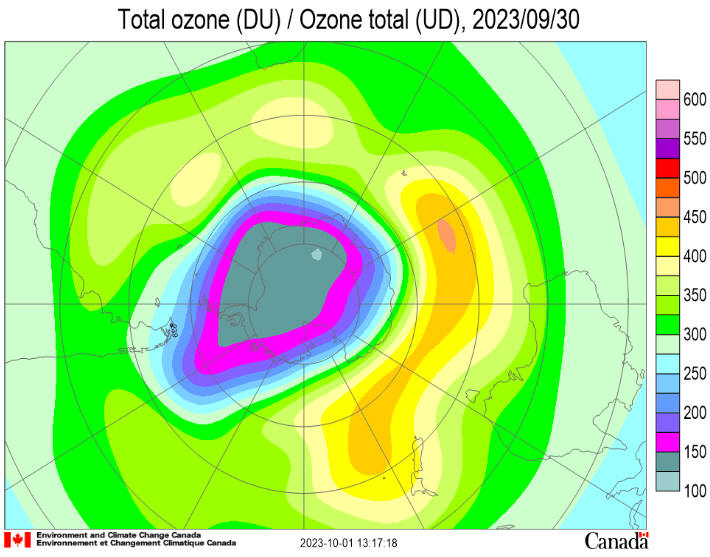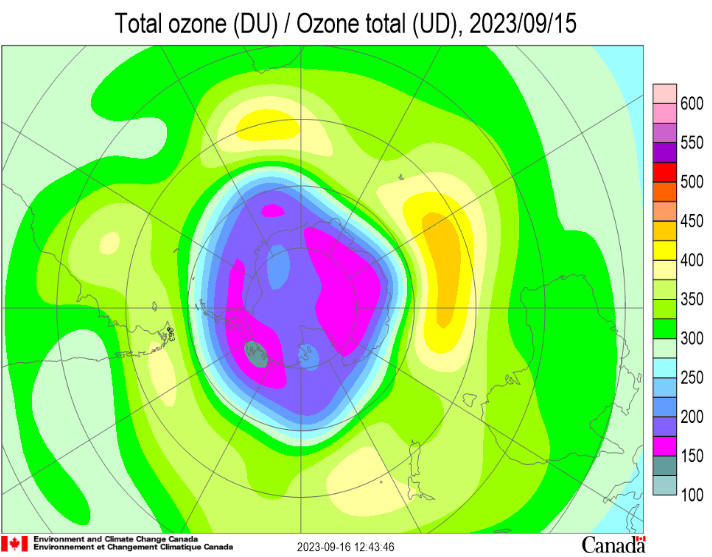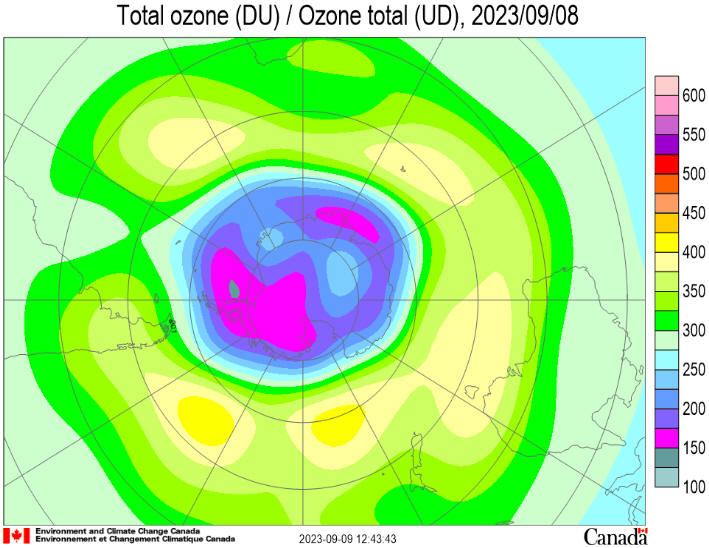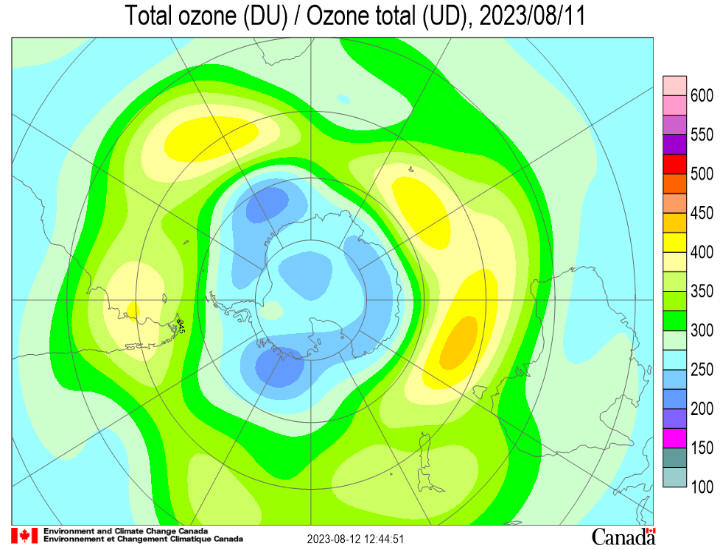|
The Ozone Hole 2023
Antarctic Situation at 2023 December 23
Antarctic ozone
today:
The 2023
ozone hole is over. The polar vortex began to form in mid May 2023
and grew to reach 33 million square kilometres (msqkm) by mid
September, close to average. It shrank slowly till early December,
then more rapidly, though at 4 msqkm it is larger than the long term
average. It became significantly less stable in the second half of
September and remained unstable until late October. The area with
potential Polar Stratospheric Clouds (PSC) also began to grow from
mid May and reached a peak of around 26 msqkm in mid July.
It
declined slowly to 22 msqkm in mid September and it then shrank more
rapidly, disappearing by October 24.
An ozone
hole formed in late June largely due to dynamical effects, reaching
an area of 3 msqkm, before disappearing again. The main ozone hole
began to form in late July and grew to 26 msqm in mid September,
near the largest over the last decade. It shrank slowly and finally
filled on December 19. It remained larger than the average over the
last decade, but similar to the last couple of years for the
majority of its existence. Ozone values continue to rise over
Antarctica and remain higher, though declining over the southern
ocean. They currently range from a low of around 230 Dobson Units
(DU) within the residual vortex over the Weddell Sea to a high of
around 360 DU outside the vortex south of Australia. The
tempehrature of the ozone layer over Antarctica is rising, and is
now above the -78°C PSC formation threshold throughout the ozone
layer. The ozone layer temperature is warmest over Antarctica and
declines towards the equator. The ozone hole elongated over South
Georgia from September 22 to 25. It stretched towards the tip of
South America in early October. The 2023 ozone hole is expected to
be over in the next few days.
PSCs were observed from Scotland on December 19 and across England
on December 21. Further sightings are likely over the next few days
as the -78°C PSC contour at 30 hPa covers most of the UK. There is a
small ozone hole to the west of the UK and here ozone values are
currently lower than anywhere over Antarctica.
2023 Ozone Hole Ranks 16th Largest, NASA and NOAA Researchers FindNASA November 1 2023 -Kathryn Cawdrey Editor’s note: This article has been updated to clarify the ranking of the 2023 ozone hole. It is the 12th largest single-day hole on record, and the 16th largest when averaged from Sept. 7 to Oct. 13. The 2023 Antarctic ozone hole reached its maximum size on Sept. 21, according to annual satellite and balloon-based measurements made by NASA and NOAA. At 10 million square miles, or 26 million square kilometers, the hole ranked as the 12th largest single-day ozone hole since 1979. During the peak of the ozone depletion season from Sept. 7 to Oct. 13, the hole this year averaged 8.9 million square miles (23.1 million square kilometers), approximately the size of North America, making it the 16th largest over this period. “It’s a very modest ozone hole,” said Paul Newman, leader of NASA’s ozone research team and chief scientist for Earth sciences at NASA’s Goddard Space Flight Center in Greenbelt, Maryland. “Declining levels of human-produced chlorine compounds, along with help from active Antarctic stratospheric weather slightly improved ozone levels this year.” The ozone layer acts like Earth’s natural sunscreen, as this portion of the stratosphere shields our planet from the Sun’s harmful ultraviolet radiation. A thinning ozone layer means less protection from UV rays, which can cause sunburns, cataracts, and skin cancer in humans. Every September, the ozone layer thins to form an “ozone hole” above the Antarctic continent. The hole isn’t a complete void of ozone; scientists use the term “ozone hole” as a metaphor for the area in which ozone concentrations above Antarctica drop well below the historical threshold of 220 Dobson Units. Scientists first reported evidence of ozone depletion in 1985 and have tracked Antarctic ozone levels every year since 1979. Antarctic ozone depletion occurs when human-made chemicals containing chlorine and bromine first rise into the stratosphere. These chemicals are broken down and release their chlorine and bromine to initiate chemical reactions that destroy ozone molecules. The ozone-depleting chemicals, including chlorofluorocarbons (CFCs), were once widely used in aerosol sprays, foams, air conditioners, fire suppressants, and refrigerators. CFCs, the main ozone-depleting gases, have atmospheric lifetimes of 50 to over 100 years. The 1987 Montreal Protocol and subsequent amendments banned the production of CFCs and other ozone-destroying chemicals worldwide by 2010. The resulting reduction of emissions has led to a decline in ozone-destroying chemicals in the atmosphere and signs of stratospheric ozone recovery. NASA and NOAA researchers monitor the ozone layer over the pole and globally using instruments aboard NASA’s Aura, NOAA-NASA Suomi NPP, and NOAA-20 satellites. Aura’s Microwave Limb Sounder also estimates levels of ozone-destroying chlorine. Scientists also track the average amount of depletion by measuring the concentration of ozone inside the hole. At NOAA’s South Pole Baseline Atmospheric Observatory, scientists measure the layer’s thickness by releasing weather balloons carrying ozonesondes and by making ground-based measurements with a Dobson spectrophotometer. NOAA’s measurements showed a low value of 111 Dobson units (DU) over the South Pole on Oct 3. NASA’s measurements, averaged over a wider area, recorded a low of 99 DUs on the same date. In 1979, the average concentration above Antarctica was 225 DU. “Although the total column ozone is never zero, in most years, we will typically see zero ozone at some altitudes within the stratosphere over the South Pole,” said NOAA research chemist Bryan Johnson, project leader for the Global Monitoring Laboratory’s ozonesonde group. “This year, we observed about 95% depletion where we often see near 100% loss of ozone within the stratosphere.” The Hunga Tonga-Hunga Ha’apai volcano — which violently erupted in January 2022 and blasted an enormous plume of water vapor into the stratosphere – likely contributed to this year’s ozone depletion. That water vapor likely enhanced ozone-depletion reactions over the Antarctic early in the season. “If Hunga Tonga hadn’t gone off, the ozone hole would likely be smaller this year,” Newman said. “We know the eruption got into the Antarctic stratosphere, but we cannot yet quantify its ozone hole impact.”
Media Contact: 2023 Ozone Hole Ranks 16th Largest, NASA and NOAA Researchers Find - NASA 21st December 2023 The Copernicus Atmosphere Monitoring Service (CAMS) The 2023 ozone hole completed its cycle after a series of twists, turns and rebounds that surprised the specialists. The ozone hole opened early and fast, becoming one of the largest on record in mid-September, and it’s one of the longest-lived observed to date. The causes of this behaviour point to climate change or volcanic emissions, but the precise reasons are not yet known. The 2023 Antarctic ozone hole finally closed on 20 December, becoming the 7th latest closing observed, according to our data. The Southern Hemisphere’s polar stratosphere temperatures rose as forecast by the Copernicus Atmosphere Monitoring Service (CAMS), and winds reduced, leading to a breakup of the polar vortex, allowing the ozone layer in the area to recover.
The 2023 ozone hole very quickly drew the attention of specialists
with an early start, leading to one of the largest ozone holes
observed in mid-September of any year.
Later the ozone hole area reduced significantly to become pretty
much within the average, but it was unusually persistent during
November, remaining over 14.2m2, roughly the area of Antarctica,
until early December, becoming the third-largest for the time of the
year in the CAMS records.
Then started the
closing process, with a series of rebounds that delayed the final
closure until 20 December. The longest-lived ozone hole in our data
record dating back to 1979 was in 1999 and 2020; both lasted until
27 December.
It is the fourth year in a row that the Southern Hemisphere’s ozone
hole showed peculiar behaviour, despite the global success in
banning ozone-depleting substances.
It is the fourth
year in a row that the Southern Hemisphere’s ozone hole showed
peculiar behaviour, despite the global success in banning
ozone-depleting substances.
Researchers suggest the eruption of the Hunga Tonga - Hunga Ha’apai
volcano in early 2022, that injected huge amounts of water vapour
into the stratosphere, might have influenced the extent and
intensity of ozone depletion in 2023. Other specialists explain that
a period of positive Southern Annular Mode could have delayed the
“final stratospheric warming” that usually concludes the ozone hole,
breaking up the polar vortex.
New research
also points to long-term atmospheric dynamics detected since the
early 2000s as a potential driver of the large ozone holes observed
in recent years, suggesting possible impacts of climate change.
Even though
research has made considerable progress in recent years, there are
still gaps in the knowledge of the precise chemical and dynamic
processes and the interactions with other layers, due to the
difficulties in obtaining observations in this remote region of our
atmosphere.
The challenge of
gathering information about our stratosphere
Researchers gather data from stratospheric balloons and satellite
observations, but the analysis can take several months or years, and
some interactions are not yet well understood, which is why there is
not an unequivocal answer to the recent changes observed in ozone
hole behaviour.
The ozone layer sits in the stratosphere at between 15 km and 30 km
altitude. It protects life on Earth from harmful ultraviolet
radiation. In the late 1970s and early 1980s scientists demonstrated
that ozone-depleting substances like chlorofluorocarbons (CFC) and
hydrofluorocarbons (HFC) accumulated in the stratosphere were
causing a seasonal thinning in the Southern Hemisphere’s ozone
layer, namely the ozone hole.
Ozone depleting substances got banned by the Montreal Protocol in
1987, but the chlorinated and brominated gases emitted prior to the
ban will remain in the atmosphere still for several decades.
NASA Ozone Watch: Latest status of ozone
British Antarctic Survey Ozone Bulletin
Antarctic Situation at 2023 December 8 Antarctic ozone today: The 2023 polar vortex began to form in mid May and grew to reach 33 million square kilometres (msqkm) by mid September, close to average. It is slowly shrinking, though at 19 msqkm is now larger than the long term average. It became significantly less stable in the second half of September and remained unstable until late October. The area with potential Polar Stratospheric Clouds (PSC) also began to grow from mid May and reached a peak of around 26 msqkm in mid July. It declined slowly to 22 msqkm in mid September and it then shrank more rapidly, disappearing by October 24. An ozone hole formed in late June largely due to dynamical effects, reaching an area of 3 msqkm, before disappearing again. The main ozone hole began to form in late July and grew to 26 msqm in mid September, near the largest over the last decade. It is now shrinking slowly and has declined to 11 msqkm, above the average over the last decade, and larger than in the last couple of years. Ozone values have passed their minimum over Antarctica and remain high over the southern ocean. They currently range from a low of around 180 Dobson Units (DU) within the vortex to a high of around 370 DU outside the vortex between South America and the Antarctic Peninsula. The temperature of the ozone layer over Antarctica is rising, and is now above the -78°C PSC formation threshold throughout the ozone layer. The ozone layer temperature is warmest just outside the polar vortex over the Antarctic Peninsula and declines towards the equator, though there is still a cold pool over East Antarctica. The ozone hole elongated over South Georgia from September 22 to 25. It stretched towards the tip of South America in early October. The ozone hole is expected to continue to shrink and fill over the coming week.
British Antarctic Survey Ozone Bulletin
Antarctic Situation at 2023 October 13
Antarctic ozone today:
The 2023 polar vortex began to form in mid May and grew to reach 33
million square kilometres (msqkm) by mid September, close to
average. It has begun to shrink but remains close to average in size
at 29 msqkm. It became significantly less stable in the second half
of September and remains unstable. The area with potential Polar
Stratospheric Clouds (PSC) also began to grow from mid May and
reached a peak of around 26 msqkm in mid July.
It declined slowly to 22 msqkm in mid September and is now shrinking
more rapidly. It is now at around 6 msqkm, close to average.
An ozone hole formed in late June largely due to dynamical effects,
reaching an area of 3 msqkm, before disappearing again. The main
ozone hole began to form in late July and grew to 25 msqm in mid
September, near the largest over the last decade. It is now
shrinking and has declined to 18 msqkm, close to the average over
the last decade. Ozone values have passed their minimum over
Antarctica and remain high over the southern ocean. They currently
range from a low of around 150 Dobson Units (DU) within the vortex
to a high of around 500 DU outside the vortex south of New Zealand.
The temperature of the bulk of the ozone layer over Antarctica is
beginning to rise, but is below the -78°C PSC formation threshold in
some lower parts. The ozone layer temperature is warmest just
outside the polar vortex and declines towards the equator and
towards the pole. The ozone hole elongated over South Georgia from
September 22 to 25. It stretched towards the tip of South America in
early October.
British Antarctic Survey Ozone Bulletin
Antarctic Situation at 2023 October 2
Antarctic ozone today:
The 2023 polar vortex began to form in mid May and grew to reach 33
million square kilometres (msqkm) by mid September, close to
average. It has shrunk a little but remains close to average in size
at 32 msqkm. It became significantly less stable in the second half
of September. The area with potential Polar Stratospheric Clouds
(PSC) also began to grow from mid May and reached a peak of around
26 msqkm in mid July.
It declined slowly to 22 msqkm in mid September and is now shrinking
more rapidly. It is now at around 15 msqkm, a little larger than
average.
An ozone hole formed in late June largely due to dynamical effects,
reaching an area of 3 msqkm, before disappearing again. The main
ozone hole began to form in late July and grew to 25 msqm in mid
September, near the largest over the last decade. It is now
shrinking and has declined to 22 msqkm, still larger than average
over the last decade. Ozone values are near their minimum over
Antarctica and building over the southern ocean. They currently
range from a low of around 120 Dobson Units (DU) within the vortex
to a high of around 460 DU outside the vortex over the Pacific
Ocean. The temperature of the bulk of the ozone layer over
Antarctica is near the winter minimum and is below the -78°C PSC
formation threshold in most of it.
It is now rising at the top of the ozone layer where it is above the
PSC formation threshold. The ozone layer temperature is warmest just
outside the polar vortex and declines towards the equator and
towards the pole. The ozone hole elongated over South Georgia from
September 22 to 25. It stretched towards the tip of South America in
early October.
British Antarctic Survey Ozone Bulletin
Antarctic Situation at 2023 September 29
Antarctic ozone today:
The 2023 polar vortex began to form in mid May and grew to reach 33
million square kilometres (msqkm) by mid September, close to
average. It has shrunk a little but remains close to average in
size. It became significantly less stable in the second half of
September. The area with potential Polar Stratospheric Clouds (PSC)
also began to grow from mid May and reached a peak of around 26
msqkm in mid July.
It is now at around 18 msqkm, still larger than average.
An ozone hole formed in late June largely due to dynamical effects,
reaching an area of 3 msqkm, before disappearing again. The main
ozone hole began to form in late July and grew to 25 msqm in mid
September, near the largest over the last decade. It is now
shrinking and has declined to 21 msqkm. Ozone values are near their
minimum over Antarctica and building over the southern ocean. They
currently range from a low of around 130 Dobson Units (DU) within
the vortex to a high of around 470 DU outside the vortex over the
Pacific Ocean. The temperature of the bulk of the ozone layer over
Antarctica is near the winter minimum and is below the -78°C PSC
formation threshold in most of it.
It is now rising at the top of the ozone layer where it is above the
PSC formation threshold. The ozone layer temperature is warmest just
outside the polar vortex and declines towards the equator and
towards the pole. The ozone hole elongated over South Georgia from
September 22 to 25. It is expected to stretch towards the tip of
South America in early October.
British Antarctic Survey Ozone Bulletin
Situation at 2023 September 22
Antarctic ozone
today:
The 2023
polar vortex began to form in mid May and has grown to 33 million
square kilometres (msqkm) since then and is near its largest. The
area with potential Polar Stratospheric Clouds (PSC) also began to
grow from mid May and reached a peak of around 26 msqkm in mid July.
It is now
at around 22 msqkm, much above average.
An ozone
hole formed in late June due to dynamical effects, reaching an area
of 3 msqkm, before disappearing again. The main ozone hole began to
form in late July and has grown to 24 msqm, near the largest over
the last decade. Ozone values are falling over Antarctica and
building over the southern ocean. They currently range from a low of
around 140 Dobson Units (DU) within the vortex to a high of around
420 DU outside the vortex over the Atlantic and Indian Oceans. The
temperature of the ozone layer over Antarctica is near the winter
minimum and is below the -78°C PSC formation threshold in most of
the Antarctic ozone layer.
The ozone
layer temperature is warmest just outside the polar vortex and
declines towards the equator and towards the pole. The ozone hole
has currently elongated towards South Georgia and ozone depletion is
expected to significantly increase over the coming ten days. During
this period it will return to a more circular shape.
British Antarctic Survey Ozone Bulletin
Antarctic Situation at 2023 September 15
Antarctic ozone
today:
The 2023
polar vortex began to form in mid May and has grown to 32 million
square kilometres (msqkm) since then and is near its largest. The
area with potential Polar Stratospheric Clouds (PSC) also began to
grow from mid May and reached a peak of around 26 msqkm in mid July.
It is now
at around 22 msqkm, somewhat above average.
An ozone
hole formed in late June due to dynamical effects, reaching an area
of 3 msqkm, before disappearing again. The main ozone hole began to
form in late July and has grown to 23 msqm, near the largest over
the last decade. Ozone values are falling over Antarctica and
building over the southern ocean. They currently range from a low of
around 140 Dobson Units (DU) within the vortex to a high of around
430 DU outside the vortex over the Indian Ocean. The temperature of
the ozone layer over Antarctica is near the winter minimum and is
below the -78°C PSC formation threshold in most of the Antarctic
ozone layer.
The ozone
layer temperature is warmest just outside the polar vortex and
declines towards the equator and towards the pole. Ozone depletion
is expected to significantly increase over the coming ten days.
British Antarctic Survey Ozone Bulletin
Antarctic Situation at 2023 September 8
Antarctic ozone
today:
The 2023
polar vortex began to form in mid May and has grown to 32 million
square kilometres (msqkm) since then and is near its largest. The
area with potential Polar Stratospheric Clouds (PSC) also began to
grow from mid May and reached a peak of around 26 msqkm in mid July.
It is now
at around 22 msqkm, close to average.
An ozone
hole formed in late June due to dynamical effects, reaching an area
of 3 msqkm, before disappearing again. The main ozone hole began to
form in late July and has grown to 21 msqm, the largest over the
last decade. Ozone values are falling over Antarctica and building
over the southern ocean. They currently range from a low of around
160 Dobson Units (DU) within the vortex to a high of around 430 DU
outside the vortex over the Southern Ocean. The temperature of the
ozone layer over Antarctica is near the winter minimum and is below
the -78°C PSC formation threshold in most of the Antarctic ozone
layer.
The ozone
layer temperature is warmest just outside the polar vortex and
declines towards the equator and towards the pole. Ozone depletion
is expected to significantly increase over the coming ten days.
British Antarctic Survey Ozone Bulletin Antarctic Situation at 2023 August 25 Antarctic ozone today: The 2023 polar vortex began to form in mid May and has grown to 30 million square kilometres (msqkm) since then. The area with potential Polar Stratospheric Clouds (PSC) also began to grow from mid May and reached a peak of around 26 msqkm in mid July. It is now at around 24 msqkm, close to average. An ozone hole formed in late June due to dynamical effects, reaching an area of 3 msqkm, before disappearing again. The main ozone hole began to form in late July and had grown to 13 msqm by August 23, which is larger than average. Ozone values are falling over Antarctica and building over the southern ocean. They currently range from a low of around 130 Dobson Units (DU) within the vortex over Halley station to a high of around 430 DU outside the vortex over the Southern Ocean. The temperature of the ozone layer over Antarctica is near the winter minimum and is below the -78°C PSC formation threshold in most of the Antarctic ozone layer. The ozone layer temperature is warmest just outside the polar vortex and declines towards the equator and towards the pole. Ozone depletion is expected to significantly increase over the coming ten days.
British Antarctic Survey Ozone BulletinAntarctic Situation at 2023 August 11Antarctic ozone today: The 2023 polar vortex began to form in mid May and has grown to 30 million square kilometres (msqkm) since then. The area with potential Polar Stratospheric Clouds (PSC) also began to grow from mid May and reached a peak of around 26 msqkm in mid July. It remains at around 25 msqkm, close to average. An ozone hole formed in late June due to dynamical effects, reaching an area of 3 msqkm, before disappearing again. The main ozone hole began to form in late July and had grown to 6 msqm by August 8. Ozone values are falling over Antarctica and building over the southern ocean. They currently range from a low of around 210 Dobson Units (DU) within the vortex to a high of around 460 DU outside it. The temperature of the ozone layer over Antarctica is near the winter minimum and is below the -78°C PSC formation threshold in most of the Antarctic ozone layer. The ozone layer temperature is warmest just outside the polar vortex and declines towards the equator and towards the pole. Ozone depletion is expected to significantly increase over the coming ten days. British Antarctic Survey Ozone BulletinAntarctic Situation at 2023 July 28 Antarctic ozone today: The 2023 polar vortex began to form in mid May and has grown to 27 million square kilometres (msqkm) since then. It is stable. The area with potential Polar Stratospheric Clouds (PSC) is also growing and has reached 25 msqkm, close to average. An ozone hole formed in late June due to dynamical effects, reaching an area of 3 msqkm, before disappearing again. Ozone values are falling over Antarctica and building over the southern ocean. They currently range from a low of around 220 Dobson Units (DU) within the vortex to a high of around 410 DU outside it. The temperature of the ozone layer over Antarctica is nearing the winter minimum. It is below the -78°C PSC formation threshold in most of the Antarctic ozone layer. The ozone layer temperature is warmest just outside the polar vortex and declines towards the equator and towards the pole. Ozone depletion is expected to significantly increase over the coming ten days.
British
Antarctic Survey Ozone Bulletin
Antarctic Situation at 2023 July 7 Antarctic ozone today: The 2023 polar vortex began to form in mid May and has grown to 23 million square kilometres (msqkm) since then. It is stable. The area with potential Polar Stratospheric Clouds (PSC) is also growing and has reached 24 msqkm, larger than usual. Ozone values are falling over Antarctica and building over the southern ocean. They currently range from a low of around 220 Dobson Units (DU) within the vortex to a high of around 410 DU outside it. The temperature of the ozone layer over Antarctica is falling from the summer maximum. It is now close to or below the -78°C PSC formation threshold in most of the Antarctic ozone layer. The ozone layer temperature is now warmest just outside the forming polar vortex and declines towards the equator and towards the pole. 31st August 2023 The Copernicus Atmosphere Monitoring ServiceAntarctic ozone hole starts amid
questions about the impact of Hunga Tonga eruption The monitoring of the early stages of the
Ozone Hole over the South Pole during 2023 by the Copernicus
Atmosphere Monitoring Service (CAMS) has detected a slightly
earlier development. Lower ozone column values in comparison to
the previous 43 years of satellite observations, together with
other key indicators, mark an early start to the ozone hole this
year. However, the evolution observed over the last week and the
CAMS forecast for the coming days show that the situation is
coming closer to the average. The early formation is possibly
related to the impact that the January 2022 eruption of the
Hunga-Tonga-Hunga Ha’apai volcano had on the composition of the
upper atmosphere. It is an open question whether it will lead to
stronger ozone depletion and a larger than usual ozone hole for
2023.
|

